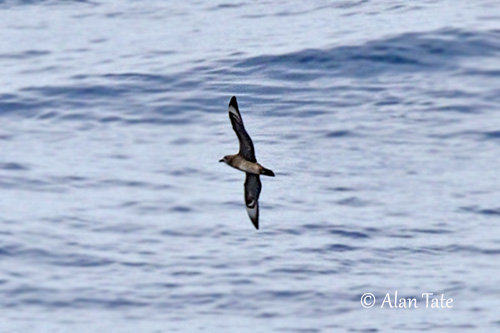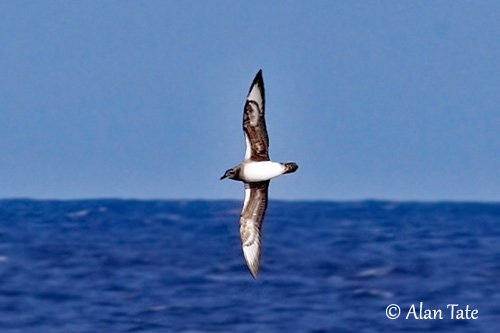
PROTECTION / THREATS / STATUS:
The Kermadec Petrel is affected by predation by invasive Polynesian Rat (Rattus exulans) which affects the success of the reproduction. Nest predation by Purple Swamphen also impacts the breeding success.
Habitat loss caused by invasive feral mammals has a negative impact on SW Pacific populations. In addition, the Kermadec Petrel is still locally collected for consumption, and eggs are collected, especially in E part of the range (Easter Island).
The population is estimated to number 150,000/200,000 individuals. It is declining but not considered globally endangered.
The Kermadec Petrel is currently evaluated as Least Concern.
Fr: Pétrel des Kermadec
Ang: Kermadec Petrel
All: Kermadecsturmvogel
Esp: Petrel de Las Kermadec
Ita: Petrello delle Kermadec
Nd: Kermadecstormvogel
Sd: kermadecpetrell
Photographers:
Alan & Ann Tate
AA Bird Photography
Text by Nicole Bouglouan
Sources:
HANDBOOK OF THE BIRDS OF THE WORLD vol 1 by Josep del Hoyo-Andrew Elliot-Jordi Sargatal - Lynx Edicions - ISBN: 8487334105
Petrels, Albatrosses, and Storm-Petrels of North America: A Photographic Guide De Steve N. G. Howell – Editor: Princeton University Press, 2012 – ISBN: 0691142114, 9780691142111 – 482pages
OISEAUX DE MER – Guide d’identification de Peter Harrison – Editions Broquet (Canada) – ISBN-10 : 2890004090 – ISBN-13 : 978-2890004092
OISEAUX des ÎLES DE L’OCÉAN INDIEN De Ian Sinclair – Editeur : Penguin Random House South Africa, 2013 – ISBN : 1775840727, 9781775840725 – 263 pages
Oceanic Birds of the World: A Photo Guide De Steve N. G. Howell, Kirk Zufelt – Editeur: Princeton University Press, 2019 – ISBN: 0691197016, 9780691197012 – 360 pages
New Zealand birds and birding (Narena Olliver)
New Zealand Electronic Text Collection
KERMADEC PETREL IN PENNSYLVANIA
Kermadec petrel recovery in Norfolk Island National Park
Page family Procellariidae
Summary cards
Kermadec Petrel
Pterodroma neglecta
Procellariiformes Order – Procellariidae Family
INTRODUCTION:
The Kermadec Petrel is a medium-sized gadfly petrel in the genus Pterodroma. Two subspecies share the large range in N and S Pacific Ocean.
The species is marine and pelagic and comes to land only to breed on vegetated coastal slopes on atolls and rocky islets. It feeds on squid and crustaceans, and takes insects when on land.
The Kermadec Petrel breeds in loose colonies. It nests on ledges in scrapes, hollows or crevices. Both parents share the nesting duties.
The Kermadec Petrel is affected by invasive Polynesian rats on some breeding islands, especially Henderson Island.
The population is declining due to habitat destruction and high levels of exploitation. But currently, the species is not listed as globally threatened.
DESCRIPTION OF THE BIRD:
Biometrics:
Length: 38 cm
Wingspan: 92 cm
Weight: 315-590 g
The Kermadec Petrel shows variable plumage morphs, ranging from birds with pale head and underparts to completely dark birds.
There are several intermediate forms, with birds showing a mid-brown head and upper breast, and white throat and rest of underparts.
The South Pacific petrels are polymorphic, whereas birds of Indian and Atlantic Oceans are predominantly or exclusively dark.
The long, pointed wings are mainly dark grey-brown with whitish primary feather shafts on the upperwing, and white flashes near the end of the underwing.
The tail is short and squared-off.

The bill is black and relatively short. The eyes are dark brown. Legs and base of feet are pink, whereas rest of feet is blackish. However, the dark morph petrels may have all-blackish legs and feet.
Male and female have similar appearance but the female is slightly smaller than male.
The juvenile resembles adult.
SUBSPECIES AND RANGE:
The Kermadec Petrel has two subspecies.
Pterodroma neglecta neglecta (described above) is found in S Pacific Ocean, from Lord Howe Islands (Phillip Island) and Kermadec Islands, E to Easter Island.
Pterodroma neglecta juana occurs in N Pacific Ocean, and breeds farther S on Juan Fernández Islands and on Desventuradas Islands (San Ambrioso and San Félix), off NC Chile.
This race is slightly larger than nominate, especially on wings of both male and female, with 9-10 mm longer than nominate.
The pale morph seems to be rare in this population.
HABITAT:
The Kermadec Petrel is marine and pelagic outside breeding season. It breeds on atolls and rocky islets in subtropical South Pacific Ocean.
The colonies are established on vegetated coastal slopes and cliffs, but also inland in mountainous areas.
The Kermadec Petrel nests on the ground, under vegetation such as ferns, shrubs or trees, and also in rock crevices, depending on availability.
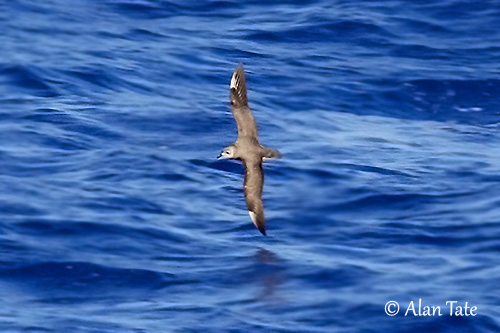
CALLS AND SONGS: SOUNDS BY XENO-CANTO
The Kermadec Petrel is usually noisy at the colonies where we can hear an explosive “yuk-ker-a-oooo-wuk”.
But the species also produces a distinctive call, both in flight and on the ground. We can hear first an introductory “kek” followed by an ascending and descending “keraaooouw” lasting three seconds. Then, a terminal “wuk-oo-wuk-oo-wuk” is given, and the latter syllables can be repeated 3-4 times.
The Kermadec Petrel is silent at sea.
BEHAVIOUR IN THE WILD:
The Kermadec Petrel feeds mainly on squid, fish and crustaceans, and takes some insects when on land.
The prey is typically caught by dipping and surface-seizing, and it may occasionally patter. But this species is also known to perform kleptoparasitism, and some tubenoses may regurgitate their prey because the Kermadec Petrel is fairly similar to a skua of family Stercorariidae.
On the other hand, it rarely follows or approaches ships.
The Kermadec Petrel is monogamous and both adults share the nesting duties.
This species forms loose colonies on atolls or islets. The nest is a scrape on a ledge, or a hollow, but it also nests in rock crevice if available. The nest-site is sometimes in open areas.
The courtship displays are poorly known, but we can suggest that the birds perform acrobatic aerial displays, like most gadfly petrels.
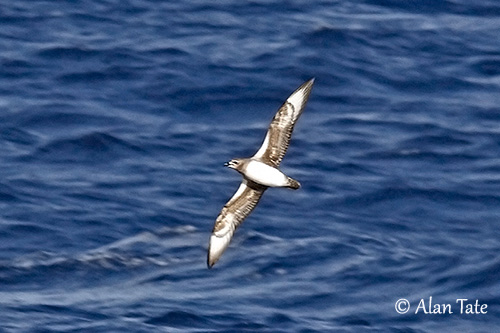
The Kermadec Petrel moves and disperses after the breeding season, over much of tropical and subtropical Pacific Ocean. Recent observations of dark morph individuals have been reported off Peru, especially off Arequipa. It has also been recorded off the west coast of America.
But there are also records from New South Wales (Australia), and the species can be seen almost anywhere in Indian and Atlantic Oceans.
Only two records off Papua New Guinea, and the species is rare in mainland New Zealand waters.
Some populations appear to be sedentary (mainly adults), with birds present year-round on Meyer Island (Kermadec Islands)
The Kermadec Petrel usually flies low to water with steep banking and gliding interspersed with loose wingbeats.
But the flight can also be strong and direct, wheeling in long glides interspersed with deep wingbeats.
At sea, this petrel uses its resemblance to skuas to attack other seabirds and steal their food. At this moment, it mainly adopts a skua-like, fast and low horizontal flight.
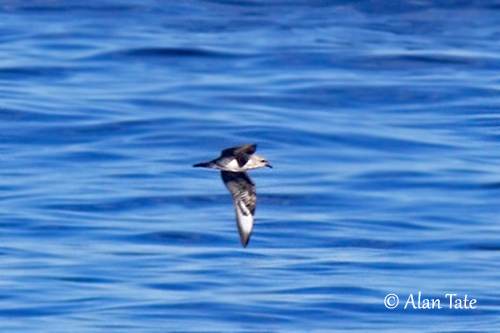
REPRODUCTION OF THIS SPECIES:
The Kermadec Petrel is unusual from the gadfly petrels group, because it uses a surface nest rather than a soil burrow. The scrape is lined with some local plant materials.
The breeding season varies depending on the locality.
In Kermadec Islands, apparently separate populations breed in summer and winter.
Elsewhere (Pitcairn Islands), most of them breed during the local summer (November-June).
On Easter Island, we can find nests with eggs in March, and young birds in August.
On the Meyer islets, nests, eggs and chicks are present in varying numbers all year, with a peak of egg-laying in February-March.
The birds arrive at the colonies up to 2,5 months prior to egg-laying. Once the nest-site is established on the ground surface, they leave for 2-3 weeks to feed at sea, before the females return to lay their eggs.
The female lays a single, large, white egg between August and March. The incubation lasts 50-52 days, shared by both adults in shifts of 18-19 days. At hatching, the chick has sooty-grey down. It fledges about 110-130 days after hatching. It is left alone by its parents 10-14 days before leaving the nest. At this period, the small chicks are often predated by crabs (Coenobita species) and Pacific Rats.
